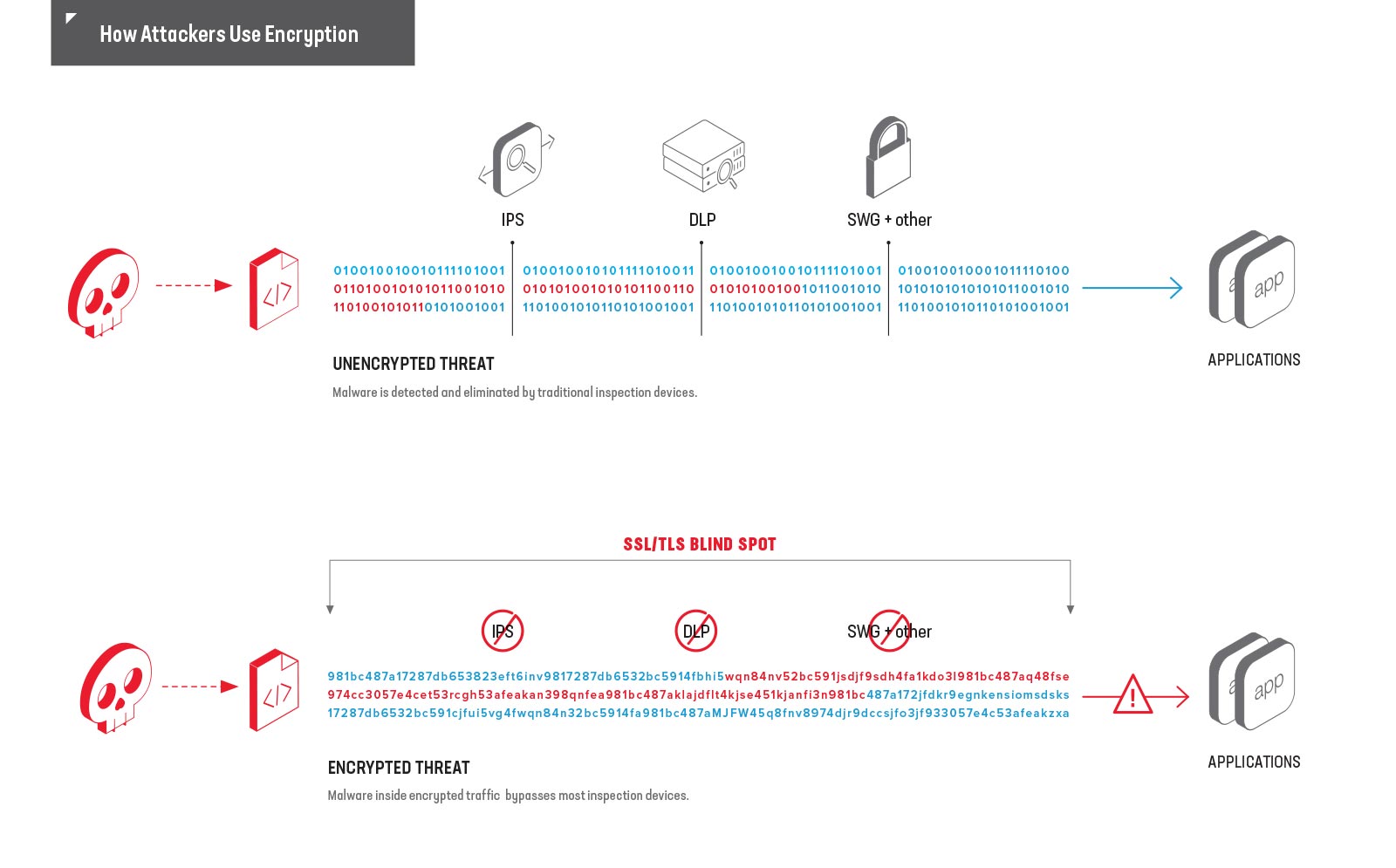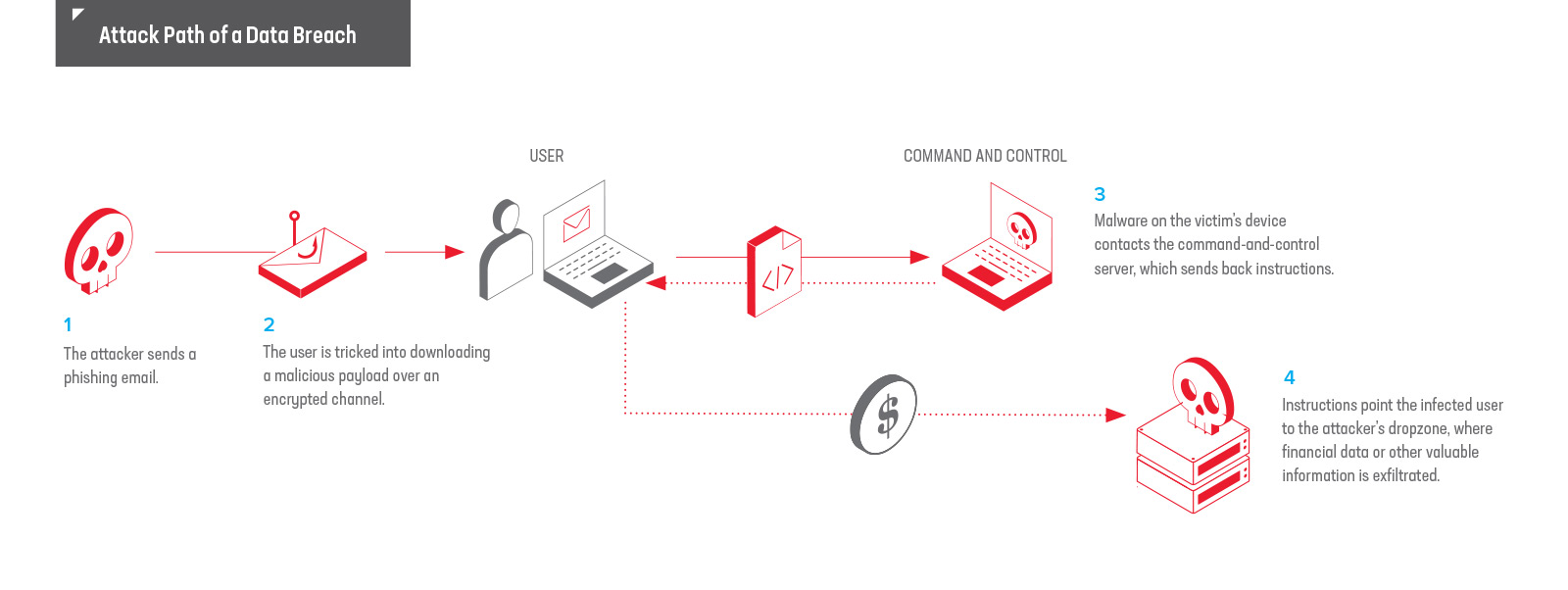SEÇÃO 1
Quase 90% de todo o tráfego da Internet é criptografado — e estamos caminhando rapidamente em direção a uma Internet onde isso será verdade para quase todos os dados em trânsito. Embora isso seja ótimo para privacidade e confidencialidade, cria um sério ponto cego para a segurança.
do malware instalado por meio de phishing está escondido na criptografia.
MALWARE CRIPTOGRAFADO: A AMEAÇA OCULTA
Ao aproveitar a criptografia, os invasores podem ignorar a maioria dos dispositivos de inspeção para instalar malware dentro da rede. Além disso, a exfiltração de dados criptografados ignora ferramentas de segurança sem análise minuciosa. A pesquisa de ameaças do F5 Labs mostra que 71% do malware usa criptografia para se esconder quando se comunica com locais de comando e controle. Além disso, 57% dos sites de malware e 95% dos sites de phishing foram acessados apenas uma vez, complicando as investigações de resposta a incidentes.
Os cibercriminosos sabem que as organizações têm dificuldades para descriptografar e inspecionar o tráfego e usam isso a seu favor. Usando malware como spyware, ransomware e rootkits, bem como exploits, os invasores comprometem usuários, redes e aplicativos para roubar dados pessoais.
Em 2018, 28% de todas as violações de dados envolveram algum tipo de malware, de acordo com o Relatório de Investigações de Violações de Dados da Verizon de 2019. Além de ser usado por organizações criminosas para ganho financeiro, o malware é cada vez mais empregado por entidades patrocinadas pelo Estado para perturbar outros países e cometer espionagem.
Obter melhor visibilidade do tráfego criptografado é uma das etapas mais importantes que você pode tomar para proteger seus aplicativos e seus negócios.
Este problema não é novo. Ao longo dos anos, o setor de segurança cibernética projetou muitas ferramentas para detectar ou bloquear malware e tráfego malicioso. As organizações implantam tecnologias como firewalls de última geração para monitorar o comportamento do usuário, sandboxes para encontrar exploits de dia zero, sistemas de proteção contra intrusão para bloquear cargas maliciosas, scanners de prevenção de perda de dados para evitar a exfiltração de dados e serviços de gateway da Web para proteger o tráfego de entrada e saída.
Essas soluções evoluíram ao longo dos anos para se tornarem aptas a impedir que malware infectasse os sistemas dos usuários e comprometesse redes ou aplicativos corporativos. No entanto, eles não foram projetados para criptografia/descriptografia em escala, então não podem examinar o que há dentro do tráfego criptografado. O aumento de dados criptografados criou uma oportunidade para invasores e uma dor de cabeça para administradores de rede. Para piorar a situação, muitos dispositivos de inspeção não conseguem acompanhar o cenário de criptografia em rápida mudança, como os requisitos para Perfect Forward Secrecy (PFS) no TLS 1.3, resultando em pontos cegos ou degradação do desempenho. Se você deseja manter seus aplicativos, seus dados e sua organização protegidos contra malware, não pode se dar ao luxo de ficar cego à criptografia.
Os criminosos usam a criptografia para evitar a detecção, e o phishing é um dos cenários de ataque mais populares.
COMO O PHISHING E O MALWARE EVITAM A DETECÇÃO
O malware criptografado é uma das ameaças mais sérias para as empresas e pode levar a perdas financeiras, danos à reputação, interrupção de serviços e violações de dados. Para agravar o problema, sempre que seus usuários acessam um site infectado ou clicam em um anexo malicioso em um e-mail de phishing, eles podem pegar um malware desagradável.
O malware adora criptografia que permite que ele passe pelo seu tráfego sem ser detectado, e o phishing é um dos cenários de ataque mais populares. Provedores de certificados HTTPS gratuitos e de baixo custo facilitam a infiltração de malware e a exfiltração de ativos roubados por invasores. No Relatório de Proteção de Aplicativos de 2019, o F5 Labs descobriu que o phishing foi responsável por 21% das violações. Aprenda como isso acontece usando malware de phishing neste breve vídeo.
DEFENDENDO-SE CONTRA AMEAÇAS CRIPTOGRAFADAS
Se você deseja manter seus aplicativos, seus dados e sua organização protegidos contra malware, não pode se dar ao luxo de ficar cego à criptografia. Obter melhor visibilidade do tráfego criptografado é uma das medidas mais importantes que você pode tomar hoje. A questão permanece: qual é a melhor maneira de fazer isso sem degradar o desempenho do aplicativo? Leia o artigo para ajudar a responder a essa pergunta.
SAIBA MAIS SOBRE PROTEÇÃO CONTRA AMEAÇAS CRIPTOGRAFADAS
Malware criptografado: A Ameaça Oculta
Na Seção 1, aprenda como os invasores podem usar criptografia para implantar malware na rede e roubar seus dados.
O TLS 1.3 é a solução?
A Seção 2 explica os recursos do TLS 1.3 e considera estratégias para adotar o protocolo de criptografia mais recente.
Inspecionando Pacotes Criptografados
Na Seção 3, descubra por que a visibilidade do tráfego criptografado é vital para proteger sua rede e seus aplicativos.
Os benefícios da orquestração
A Seção 4 explora como a orquestração SSL/TLS pode ajudar a maximizar a eficácia e o ROI de suas soluções de segurança.
FALE COM OS ESPECIALISTAS EM SEGURANÇA DA F5
Tem alguma pergunta de segurança, problema ou algo mais que gostaria de discutir? Gostaríamos muito de ouvir de você!
Entraremos em contato com você por e-mail em até um dia útil.


